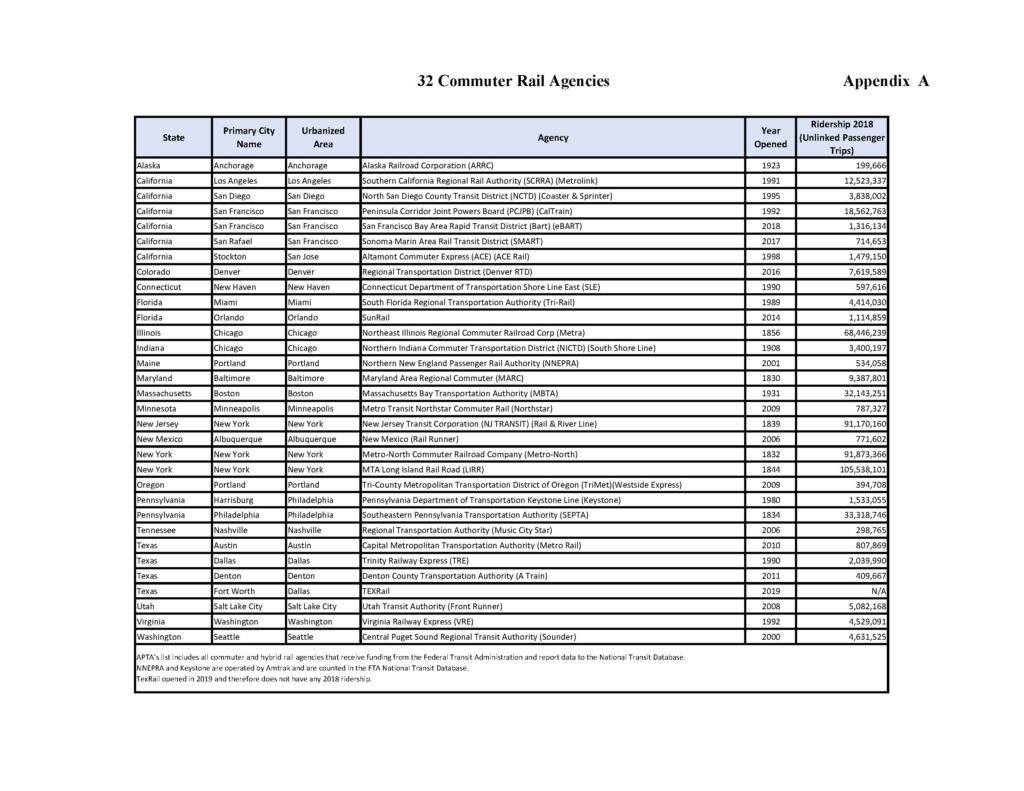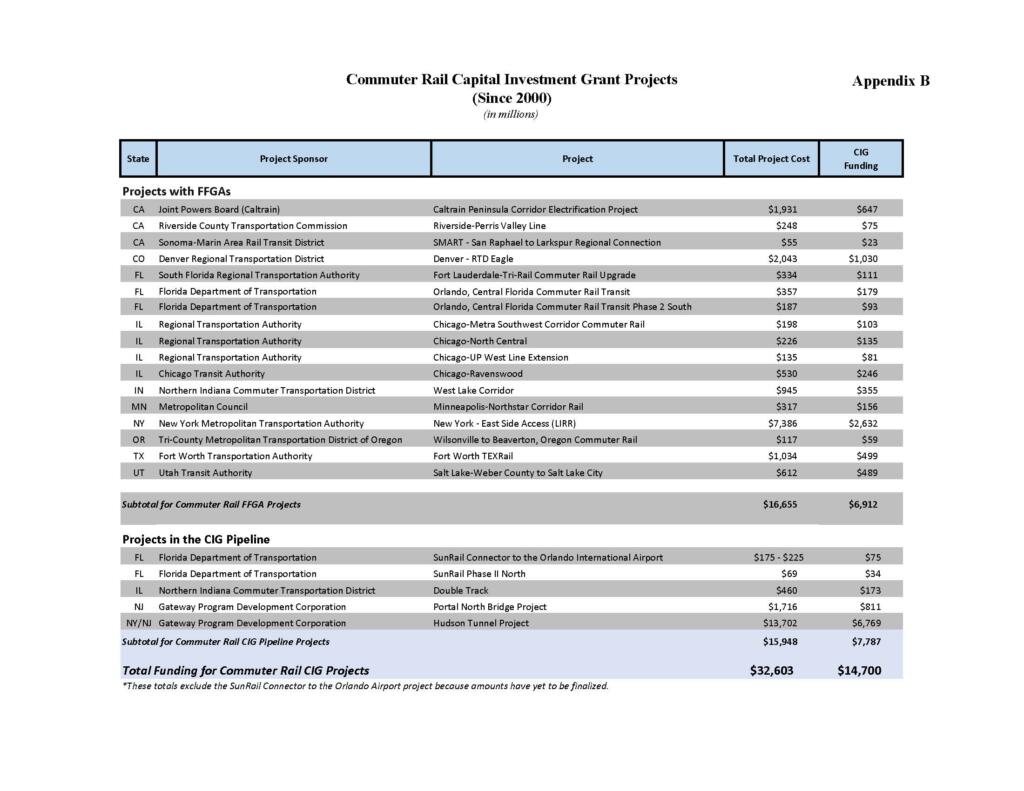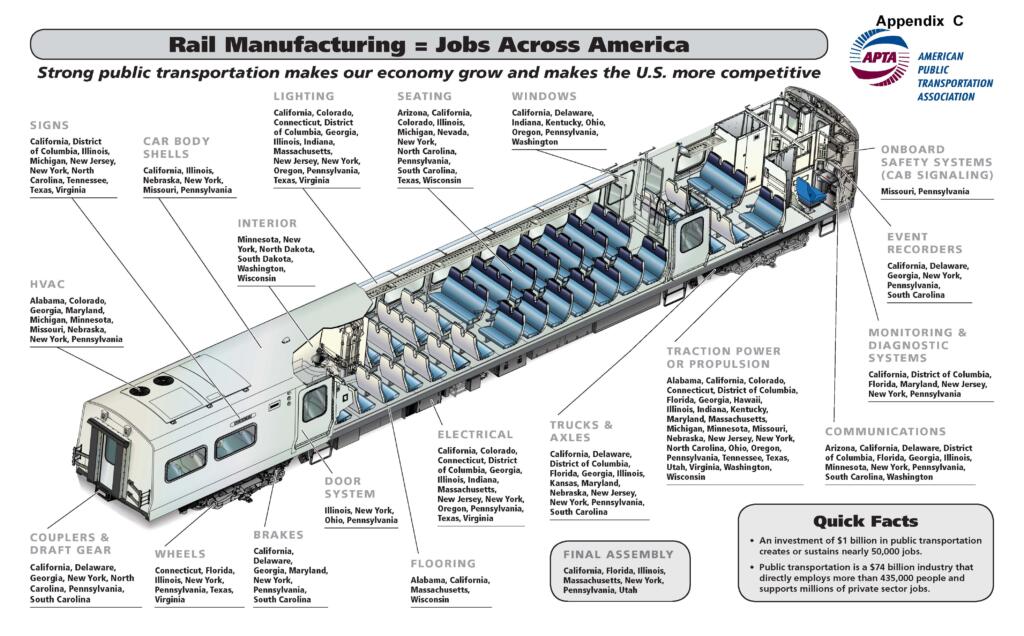Testimony of
Paul P. Skoutelas
President and CEO
American Public Transportation Association
Hearing on “Examining the Surface Transportation Board’s Role in Ensuring a Robust Passenger Rail System”
Introduction
Chairman Lipinski, Ranking Member Crawford, and Members of the Subcommittee on Railroads, Pipelines, and Hazardous Materials, on behalf of the American Public Transportation Association (APTA) and its 1,500 public- and private-sector member organizations, thank you for the opportunity to testify on “Examining the Surface Transportation Board’s Role in Ensuring a Robust Passenger Rail System”.
My name is Paul Skoutelas, and I am the President and Chief Executive Officer (CEO) of APTA, an international association representing a $74 billion industry that employs 435,000 people and supports millions of private-sector jobs. We are the only association in North America that represents all modes of public transportation—bus, paratransit, light rail, commuter rail, subways, waterborne services, and high-performance intercity passenger rail.1
Prior to joining APTA in January 2018, I served as national director of WSP USA’s Transit & Rail Technical Excellence Center where I provided strategic direction on public transit and rail projects. Earlier in my career, I was CEO at two major public transportation agencies: the Port Authority of Allegheny County in Pittsburgh, Pennsylvania, and the Central Florida Regional Transportation Authority (LYNX) in Orlando, Florida.
Commuter Rail and The Surface Transportation Board
Nearly 40 years ago, Congress enacted the Northeast Rail Services Act of 1981 (P.L. 97-35) to salvage commuter rail operations from Conrail and created six commuter rail authorities.2 The state of commuter rail at that time suffered from low and declining ridership and equipment long beyond its useful life. These agencies and the many others across the nation that existed then or have started anew have transformed commuter rail into an essential, reliable, growing, safe, and affordable mobility option carrying hundreds of millions of travelers each year.
Today, there are 32 agencies operating commuter railroads.3 Commuter rail services are higher speed, higher capacity trains with less frequent stops. They are traditionally used to connect people from suburban areas to city centers. Prior to the coronavirus pandemic, 32 agencies operating commuter railroads, safely carried passengers on more than 500 million trips each year.
In the last decade, nine new commuter rail systems4 have begun operation, with the latest—TexRail in Fort Worth, Texas—starting up last year. Before the COVID-19 pandemic, commuter rail enjoyed nearly constant annual ridership growth—growing by more than 42 million passenger trips (9.2 percent) over the last decade. Commuter rail also increased fare recovery (fare revenue as a percent of operating costs) in the last decade. On average, fares recovered more than one-half (52 percent) of the operating costs of commuter railroads.
Commuter railroads’ success in advancing their reach is dependent, in part, on the Surface Transportation Board (STB) ensuring a robust passenger rail system. While the majority of the agency’s jurisdiction revolves around freight rail, the STB is charged with adjudicating service disputes that may arise between commuter rail, freight railroads, and Amtrak.
Commuter Rail Access to Freight Railroad Rights of Way
Commuter rail connects people to jobs and opportunity each and every day. For commuter railroads to expand existing service or initiate new service, access to freight railroad rights of way is essential. Commuter railroads are often at a disadvantage when seeking to utilize freight rail rights of way, as they have no statutory priority for such access. Federal policies should encourage the growth of both passenger rail and freight rail operations on existing rail lines.
Currently, Amtrak has the statutory right to access the rail lines or facilities of a rail carrier or regional transportation authority and has preferential use rights over freight railroads when conducting intercity or commuter rail passenger transportation.5 However, other passenger rail services (including commuter rail and high-speed rail) do not have the same right of access or preference. As the Committee considers the surface transportation authorization bill in the 117th Congress, APTA would like to work with you and our rail partners, including Amtrak and the freight railroads, to explore the best opportunities to ensure equitable access for all passenger rail on freight rail lines. A robust passenger rail system is critical to ensure our post-pandemic economic recovery.
APTA is grateful for the Committee’s recognition that commuter rail authorities need to have an equitable and fair process for negotiating passenger rail operational access on freight railroad trackage and rights-of-way. H.R. 2, the INVEST in America Act, included two provisions to enhance the STB’s role in mediating disputes.6 Sections 9401 and 9402 of H.R. 2 address the STB’s authority to mediate disputes involving commuter rail track usage and service requests as well as rights-of-way usage requests for the construction and operation of a segregated fixed guideway facility. Importantly, both provisions in H.R. 2 require a rail carrier to provide good faith consideration to reasonable access and usage requests. If an agreement cannot be reached between the public transportation authority and the rail carrier, either party can apply to the STB for nonbinding mediation. If this language is passed into law, APTA encourages the STB to ensure that rail carriers provide full and fair consideration to commuter rail requests for track and right-of-way access and usage.
The STB could also be instrumental in ensuring that any unused capacity on freight rail lines is defined and the railroad owner is fairly compensated for available capacity and, where there is insufficient capacity, a fair and equitable process is created to enhance capacity. We strongly encourage the STB to conduct a summit on capacity to discuss the appropriate parameters to allow for the efficient allocation and use of capacity on freight rail lines for passenger rail operations. One outcome of the summit could be an agreed-upon tool to define capacity. APTA notes that after positive train control is fully implemented, additional capacity may become available and provide opportunities for passenger rail service expansion.
In addition, after the Federal Railroad Administration (FRA) completes its rulemaking on Metrics and Minimum Standards for Intercity Passenger Rail Service,7 the STB will play a very important role in investigating and resolving any disputes that arise after the standards are finalized.8 It is critically important that any implementation of the final rule take into account the individual performance of rail carriers, including commuter railroads, on multi-carrier routes so as not to unduly subject such carriers to the costs and burdens of associated investigations that are unrelated to their service delivery.
Finally, APTA notes that the STB is currently operating without a full complement of Board members. The Board has three confirmed members and the Chair’s term expires in December 2020. Two nominees are pending in the Senate. If the nominations are not approved before the end of this Congress, the STB’s ability to conduct routine business may be impacted. Commuter and passenger railroads need certainty and a strong regulatory structure to ensure quick resolution of disputes by the STB. APTA is hopeful that the Senate will approve these pending nominations to the STB without delay to ensure that the Board is able to conduct its business at the beginning of next year.
Commuter Rail Liability Insurance
Commuter rail agencies are facing rapidly escalating costs to procure necessary liability insurance for their operations. Railroad liability insurance is considered a specialty product by the insurance industry. Only a handful of insurers offer this coverage, and a significant percentage of the railroad liability insurance marketplace is provided by foreign companies. The federally mandated minimum liability insurance coverage for commuter railroads is $295 million. In addition, some commuter railroads are required to buy additional insurance coverage as a result of contractual obligations with the freight railroads to operate on their tracks or by state law.
The number of insurers in the excess market willing to even offer potential capacity for this coverage has drastically decreased over the past several years. Regardless of cost, it is becoming extremely difficult to obtain the needed coverage up to the required limits. Each policy is custom-made for the particular commuter rail agency, with negotiated terms and premiums. Premiums for these policies, which must be paid annually, range from $1 million to $4 million. Given the fact that only a small number of insurers provide commuter rail insurance, the negotiating power of commuter rail agencies is more limited than it would be in the traditional insurance marketplace.
Despite commuter railroads’ exceptional safety record, a recent survey of APTA’s commuter rail agencies revealed that there has been a 60 percent increase in premium costs over the last three years and the cost of liability insurance is severely impacting the operating budgets of many commuter rail agencies. The increase in premiums are largely due to factors outside the control of the commuter rail industry, including losses in the commercial trucking sector, major forest fires, hurricanes, increased jury awards, and insurers exiting the market.
In advance of the next surface transportation authorization bill, APTA is undertaking research to illustrate how liability costs have increased for the commuter rail industry and identify the reasons for the increases. There are a number of instances where federal law provides a backstop to cover losses above liability limits or allows for federal intervention where the insurance marketplace has become noncompetitive and premiums unaffordable. APTA is developing a proposed legislative framework to reduce liability insurance premium costs for commuter railroads for the Committee to consider in the next Congress.
Commuter Rail’s Essential Role During the Pandemic
Commuter rail is essential to our nation’s economy. America’s commuter railroads create and support more than 200,000 public- and private-sector jobs. The COVID-19 pandemic has illustrated the essential lifeline that transit, including commuter rail, plays in our communities—bringing healthcare professionals to the frontlines, delivering groceries and medicine to at-risk populations, and connecting essential workers to their places of work.
Public Transportation is Safe
Public transportation continues to provide the safest and most sustainable way to connect people to jobs and opportunity each day. COVID-19 and the concomitant shelter-in-place orders, business closures, suspension of tourism, and increasing unemployment significantly decreased public transit and commuter rail ridership. Our commuter rail agencies adapted quickly to protect employees and the public through increased cleaning and disinfecting procedures at significant direct costs. Combating the public perception that public transportation spreads COVID-19 remains a significant barrier as transit agencies work to increase ridership.
APTA recently commissioned a study to compile the latest global research on COVID-19 transmission and transit, and successful mitigation strategies to protect both employees and the public.9 The study found that there has been no direct correlation between use of urban transit and transmission or contraction of the coronavirus. Thus, there is minimal risk from using transit provided specific safeguards are in place, such as face coverings, well-functioning ventilation systems, and minimal talking by riders.10
Transit Agencies Need Additional COVID Relief Funding
The Coronavirus Aid, Relief, and Economic Security Act (CARES Act) funding of $25 billion provided a critical lifeline to enable our agencies to serve first responders, hospital workers, and grocery store clerks each and every day. We are extremely thankful to Congress for recognizing the vital role that public transportation has played throughout the pandemic.
According to the Federal Transit Administration (FTA), as of November 11, 2020, public transit agencies have obligated 94 percent of CARES Act transit funds through 760 grants totaling nearly $23.4 billion of the $25 billion appropriated; more than one-half (57 percent) of these funds have been fully expended. Moreover, FTA is currently processing an additional 92 grants, totaling $265 million, of CARES Act funds.
Over the past several months, in many states, things have taken a turn for the worse—coronavirus cases are spiking, governors and mayors are renewing stay-at-home orders, and businesses are shutting down. Our railroads have faced ridership declines of close to 90 percent with a corresponding loss in farebox revenues. In addition, agencies across the country are gaining a clearer understanding of the impact that the pandemic is having on sales taxes, gas taxes, and other state and local revenue streams linked to the economy.
APTA estimates that the shortfall of additional transit COVID-19 costs and revenue losses is now at least $32 billion. Without additional emergency funding, many transit agencies, including commuter rail agencies, will need to consider cutting transit services and routes and furloughing transit workers.11 Transit systems, both large and small, are also predicting significant budget shortfalls due to declining revenues heading into fiscal year 2021 without additional federal support.
As our nation’s commuter rail agencies work to maintain and restore essential services, federal support is critical to ensure that they can reposition themselves to survive and help our communities and nation recover from the economic fallout of the pandemic. Time is of the essence in securing this additional emergency funding.
APTA strongly supports H.R. 925, “The Heroes Act”, which provides $32 billion of emergency transit funding. In addition, APTA supports Amtrak’s request for $4.9 billion in COVID emergency relief. We stand ready to work with this Committee and Congress to ensure that additional COVID-19 emergency funding for public transportation and Amtrak is passed before the end of the year.
Passenger Rail Investment
As commuter railroads begin to recover from the COVID-19 pandemic, we strongly urge Congress to increase federal funding for public transportation, including commuter rail. The INVEST in America Act includes a rail title, the Transforming Rail by Accelerating Investment Nationwide (TRAIN) Act, which authorizes $60 billion to address rail infrastructure needs, expand intercity passenger rail routes, and provides enhanced availability of funding to commuter rail agencies. APTA is grateful for the robust funding for passenger rail, and the focus on investing in commuter rail through the Consolidated Rail Infrastructure and Safety Improvement (CRISI) program. The INVEST Act authorized CRISI at $7 billion over five years, and explicitly made commuter rail agencies eligible to compete for CRISI funding.
In addition, the INVEST Act provides $105 billion for public transit. Commuter railroads also receive federal funding through FTA, namely Section 5307 Urbanized Area Formula grants and Section 5337 State of Good Repair grants. In addition, commuter railroads are eligible for FTA’s Section 5309 Capital Investment Grants (CIG) program. Since 2000, 17 commuter rail projects have received Full Funding Grant Agreements under the CIG program. In addition, five commuter rail projects, requesting over $7.5 billion, are in the CIG pipeline.12
The economic benefits of these projects reach far beyond the railroad’s specific region. For example, a commuter rail project in California may include parts, materials, or equipment from a supplier in Kansas, South Carolina, Utah or Wisconsin. These commuter rail projects also represent thousands of construction jobs, manufacturing jobs, and other jobs generated by multiplier effects associated with spending on parts and materials. Appendix C illustrates the jobs created across America in rail car manufacturing.
APTA strongly supports the funding levels in the INVEST Act and encourages the Committee to continue this robust funding for public transportation and passenger rail in the surface transportation authorization bill in the 117th Congress.
Conclusion
On behalf of APTA, thank you for giving me the opportunity to testify and share our thoughts on “Examining the Surface Transportation Board’s Role in Ensuring a Robust Passenger Rail System”. We look forward to continuing to work with the Committee on Transportation and Infrastructure as it pursues the INVEST in America Act in the next Congress. It is imperative that we make meaningful investments and enact policy in commuter rail to enable these critical services to continue to grow, serve our communities, and contribute to the national economy.



1 APTA members include public transportation systems; planning, design, construction, and finance firms; product and service providers; academic institutions; state transit associations; and state departments of transportation.
2 The six commuter rail authorities are the: Metropolitan Transportation Authority; Connecticut Department of Transportation; Maryland Department of Transportation; Southeastern Pennsylvania Transportation Authority; New Jersey Transit Corporation; and Massachusetts Bay Transportation Authority.
3 A list of commuter railroad agencies can be found in Appendix A. APTA’s list includes all commuter and hybrid rail agencies that receive funding from the Federal Transit Administration (FTA) and report data to the National Transit Database.
4 The nine new systems are Portland, OR (Westside Express, 2009); Minneapolis, MN (Northstar, 2009); Austin, TX (Capital MetroRail, 2010); Denton, TX (A Train, 2011); Orlando, FL (SunRail, 2014); Denver, CO (A Line, 2016); Marin County, CA (SMART, 2017); Antioch, CA (eBART, 2018); and Fort Worth, TX (TEXRail, 2019).
5 See 49 U.S.C. §§ 24308 (a) and (c).
6 49 U.S.C. § 28502 and § 28503 currently provide the STB with the authority to mediate disputes between commuter rail authorities and the freight railroads.
7 See 85 Fed. Reg. 17835, Docket Number FRA-2019-0069 (March 31, 2020).
8 See 49 U.S.C. § 24308(f).
9 APTA, Public Transit and COVID-19 Pandemic: Global Research and Best Practices (Sam Schwartz Consulting, September 2020).
10 Id. at 4.
11 APTA Policy Brief, COVID-19 Pandemic Threatens Public Transit Jobs and Service (September 2020).
12 A list of the CIG projects with Full Funding Grant Agreements and those in the CIG pipeline is in Appendix B.



